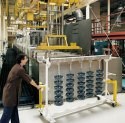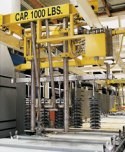Total Control Anodizing
Landmark anodizing system is excellent for semiconductor toolmakers...
Semiconductor manufacturing is a high-stakes industry loaded with secrets. Among the most closely guarded are those secrets related to the complex tools used in the manufacturing process. "Tools" in this industry are the devices used to make semiconductor wafers, which are essentially complex vacuum chambers where plasma etching occurs. In this process, gas reacts to form a plasma, thereby etching surface areas not covered by a photoresistant masking material. This creates a micro-condition (a channel) on the face of a silicon chip.
Numerous parts within the chamber are anodized to protect the hardware from the corrosive effects of the plasma and gases. Anodizing also gives dielectric protection so that the plasma is sustained where it is needed. Dielectric strength, the voltage breakdown strength, is a critical measurement of the surface coating.
Confidentiality umbrellas cover virtually every aspect of tool design, function, manufacturing and finishing. Rare is the glimpse into this unique industry, where channels are one-fifth the dimension of a human hair and finishing is measured in billionths of an inch.
In 1995, Walgren Company, Grand Rapids, MI, was commissioned to design and build a landmark anodizing line for use in coating new componentry made by one of the world's leading semiconductor toolmakers. A secondary role for the line was in related technical anodizing markets and refinishing formerly anodized components. The line was installed at Treffers Precision, Inc., Phoenix, AZ, a subsidiary of Praxair Surface Technologies, Inc.
Walgren had supplied Treffers with an anodizing system and support equipment 20 years before. The equipment is still used for aerospace parts manufactured for Boeing, Allied Signal and major airlines. Aerospace work comprises a significant portion of Treffers' customer base.
System design was a joint effort between the toolmaker OEM, Walgren and Treffers. Repeatability of results, traceability and absolute process control were the primary objectives. Treffers also wanted the line to provide extensive data collection, detailed, long-range archiving and the capability to expand quickly and without disrupting production. The latter would be important both during the semiconductor industry's high-growth years and during years when growth levels off and the emphasis would be on developing projects in other market sectors to compensate for the loss.
Clearly, Treffers' system is one of the most automated anodizing lines operating in the United States. There are 34 stages, spanning 120 linear ft, and the line was engineered to operate on a 24-hour, 7-day-a-week basis. There are four independent computers. The first runs the hoists, activates the system's 20 rectifiers and governs the dwell time in each tank. The system has true random capability; separate recipes can be entered for each part and each load bar.
Managing conditions for the rectifiers (4 bays with 5 rectifiers in each) is the task of the second computer, which forwards its information to a data computer.
The analyzer computer manages and analyzes all of the physical and chemical parameters involved with system operation, such as temperature, concentration and conductivity. The fourth data computer compiles the system history and correlates the data from the other three computers.
Individual tanks are 7 ft long by 4 ft deep by 2 ft wide and are built in a chemical containment well. Tanks are serviced by two automatic hoists that run in series. An automatic analyzer checks each tank, maintains proper chemistry, automatically activates replenishment when needed and handles other critical line functions such as filtering process tanks and final rinses. Filter pressure is monitored continuously and automatically indicates when a cartridge change is warranted. Sensors also monitor air agitation. Except for programming, the line operates free of human intervention.
At the start of the cycle, the operator enters a part serial number. This generates a hoist and rectifier recipe and calls up a set of specifications indicating which tanks will be involved and for how long. It also indicates flow rates, chemical concentrations and temperatures. The system then determines what loads are currently in the line and confirms tank conditions. If all elements are within the specified parameters, the system will process the load. If some element is outside its target range, the system will not allow the operator to start and will hold the load until the conflict is resolved.
Processes in the system are an alkaline non-etch soap clean; ultrasonic clean; acidic deoxidize; alkaline etch, deoxidize; hard or sulfuric acid anodize; nickel acetate seal or deionized water seal; and dry. Triple counterflowed rinses separate each chemical stage. Resistivity sensors in the rinse tanks control the flow of high-purity deionized water.
As parts progress through the system, they are accompanied by a detailed history of every process they went through. This information, along with data on tank temperatures, chemical purity and other specifications, is also fed to a database that is accessible via modem dial-in. Therefore, the toolmaker, Treffers' management and technical support personnel can review and discuss system status and performance in detail and in real time.
The system provides continuous monitoring of every tank and every component of every aluminum alloy processed. Routine decanting prevents the accumulation of impurities such as dissolved aluminum in the etch tank and guards against metallic impurities such as copper. All analyzer instrumentation self-calibrates daily.
Cycle length is generally one to three hours, depending on the anodizing thickness specified and how long parts remain in the seal stage. To assure continuous operation, critical system components, including hoists, heat exchangers, chillers and pumps are redundant and can be activated with a simple turn of a valve. Air emission controls for the Treffers line were supplied as part of the Price Walgren package by Tri-Mer Corp., Owosso, MI. The fan/separator fume scrubbers are notable for their low water use, which is 60% less than average conventional scrubber designs. They also feature low internal static pressure, which translates to lower utility costs.
Both fan/separator units are manufactured from PVC. A 12,000-cfm unit serves the anodizing tanks. An 8,000-cfm unit serves the deoxidizing and etching tanks. Both operate continuously at 95% plus efficiency.
Wastewater treatment was also provided as part of the anodizing system package. The system provides continuous flow-through neutralization, clarification and filtration stages. Precipitates from the nickel seal bath, the only stage with a heavy metal component, are segregated and treated separately. The line generates only non-hazardous effluent, and there is no heavy metal discharge. The system operates free of cyanide, chromium and solvents and was recently recognized by the city of Phoenix for its pro-environmental policies and violation-free operation.
With the successful commissioning of the line, Treffers is poised for significant growth and expansion of its business base. Augmenting its important work with semiconductor etching is a project for the broader semiconductor industry, such as the processing of heat shields and the manufacture of aluminum-based medical devices used in laboratory testing and analysis, where aluminum is the preferred substrate and high traceability is critical.
Future expansion may also be facilitated by a blank spot left in the line where an additional tank can be added for a dye, bright dip or other stage. Provisions were also made for filtration of that "phantom tank" and for connecting it to the scrubber.
Treffers parent company, Praxair Surface Technologies, is one of the world's largest surface enhancement technical organizations.
Other quality control, such as thickness and surface roughness testing, is customer specific. All monitored line parameters flow to a database. Predictive software allows the generation of SPC charts and extensive statistical analysis. Thus, if something begins to trend away from the target, it can be corrected quickly and proactively.
Treffers Precision believes it is on track for the future. According to Dave Henderson, business group marketing manager, "The demand for tightly controlled and process of record anodizing continues to be strong. The tools we have, specific recipes, addition of other coatings in combination, repeatable variations of those recipes and the link to Praxair, put us in a unique position to develop new and better answers to customer problems. This will be part of the future for anodizing."
To learn more visit Price Walgren and Tri-Mer Corp.
Read Next
Episode 45: An Interview with Chandler Mancuso, MacDermid Envio Solutions
Chandler Mancuso, technical director with MacDermid Envio discusses updating your wastewater treatment system and implementing materials recycling solutions to increase efficiencies, control costs and reduce environmental impact.
Read MoreDelivering Increased Benefits to Greenhouse Films
Baystar's Borstar technology is helping customers deliver better, more reliable production methods to greenhouse agriculture.
Read MoreEducation Bringing Cleaning to Machining
Debuting new speakers and cleaning technology content during this half-day workshop co-located with IMTS 2024.
Read More
















.jpg;maxWidth=300;quality=90)






